2022 TOYOTA SIENNA HYBRID steering
[x] Cancel search: steeringPage 488 of 600
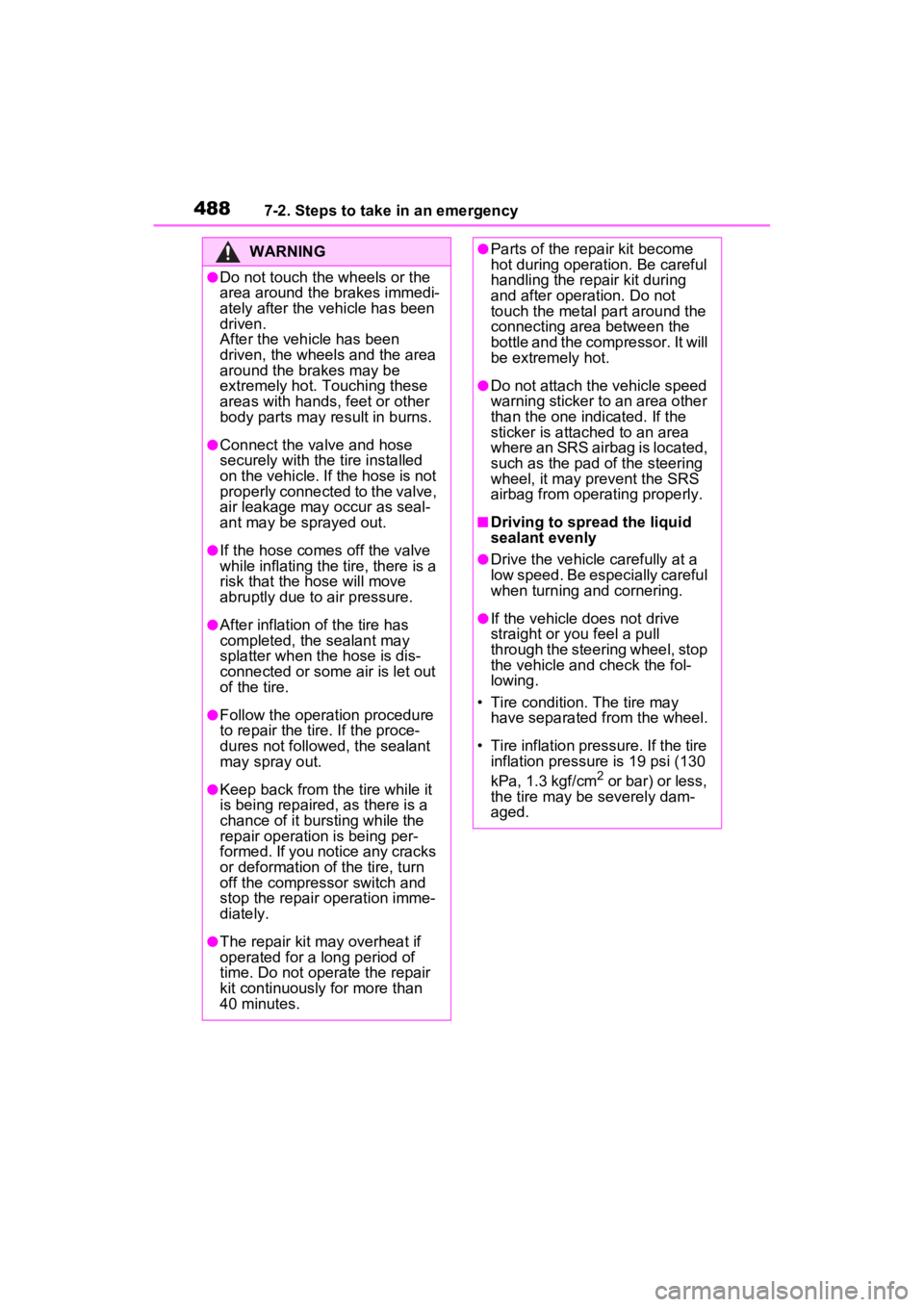
4887-2. Steps to take in an emergency
WARNING
●Do not touch the wheels or the
area around the brakes immedi-
ately after the vehicle has been
driven.
After the vehicle has been
driven, the wheels and the area
around the brakes may be
extremely hot. Touching these
areas with hands, feet or other
body parts may result in burns.
●Connect the valve and hose
securely with the tire installed
on the vehicle. If the hose is not
properly connected to the valve,
air leakage may occur as seal-
ant may be sprayed out.
●If the hose comes off the valve
while inflating the tire, there is a
risk that the hose will move
abruptly due to air pressure.
●After inflation of the tire has
completed, the sealant may
splatter when the hose is dis-
connected or some air is let out
of the tire.
●Follow the operation procedure
to repair the tire. If the proce-
dures not followed, the sealant
may spray out.
●Keep back from the tire while it
is being repaired, as there is a
chance of it bursting while the
repair operation is being per-
formed. If you notice any cracks
or deformation of the tire, turn
off the compressor switch and
stop the repair operation imme-
diately.
●The repair kit may overheat if
operated for a long period of
time. Do not operate the repair
kit continuously for more than
40 minutes.
●Parts of the re pair kit become
hot during operation. Be careful
handling the repair kit during
and after operation. Do not
touch the metal part around the
connecting area between the
bottle and the compressor. It will
be extremely hot.
●Do not attach the vehicle speed
warning sticker to an area other
than the one indicated. If the
sticker is attached to an area
where an SRS airbag is located,
such as the pad of the steering
wheel, it may prevent the SRS
airbag from operating properly.
■Driving to spread the liquid
sealant evenly
●Drive the vehicle carefully at a
low speed. Be especially careful
when turning and cornering.
●If the vehicle does not drive
straight or you feel a pull
through the steering wheel, stop
the vehicle and check the fol-
lowing.
• Tire condition. The tire may have separated from the wheel.
• Tire inflation pressure. If the tire inflation pressure is 19 psi (130
kPa, 1.3 kgf/cm
2 or bar) or less,
the tire may be severely dam-
aged.
Page 497 of 600

4977-2. Steps to take in an emergency
7
When trouble arises
WARNING
●Do not use more than one com-
pact spare tire simultaneously.
●Replace the compact spare tire
with a standard tire as soon as
possible.
●Avoid sudden acceleration,
abrupt steering, sudden brak-
ing and shifting operations that
cause sudden engine braking.
■When the compact spare tire
is attached
The vehicle speed may not be
correctly detecte d, and the follow-
ing systems may not operate cor-
rectly:
• ABS & Brake assist
• VSC/Trailer Sway Control
• TRAC
• Dynamic radar cruise control with full-speed range
• PCS (Pre-Collision System)
• EPS
• LTA (Lane Tracing Assist)
• Tire pressure warning system
• AHB (Automatic High Beam)
• BSM (Blind Spot Monitor) (if equipped)
• Rear view monitor system (if equipped)
• Panoramic view monitor (if equipped)
• Toyota parking assist monitor (if equipped)
• Intuitive parking assist (if equipped)
• PKSB (Parking Support Brake) (if equipped)
• Navigation system (if equipped)
Also, not only c an the following
system not be utilized fully, but it
may actually negatively affect the
drive-train components:
• E-Four (Electronic On-Demand
AWD system) (AWD models)
■Speed limit when using the
compact spare tire
Do not drive at speeds in excess
of 50 mph (80 km /h) when a com-
pact spare tire is installed on the
vehicle.
The compact spare tire is not
designed for driving at high
speeds. Failure to observe this
precaution may lead to an acci-
dent causing death or serious
injury.
■After using the tools and jack
Before driving, ma ke sure all the
tools and jack are securely in
place in their storage location to
reduce the possibility of personal
injury during a collision or sudden
braking.
NOTICE
■Be careful when driving over
bumps with the compact
spare tire installed on the
vehicle
The vehicle height may become
lower when drivi ng with the com-
pact spare tire compared to when
driving with standard tires. Be
careful when driving over uneven
road surfaces.
■Driving with tire chains and
the compact spare tire
Do not fit tire chains to the com-
pact spare tire.
Tire chains may damage the vehi-
cle body and adversely affect driv-
ing performance.
Page 522 of 600
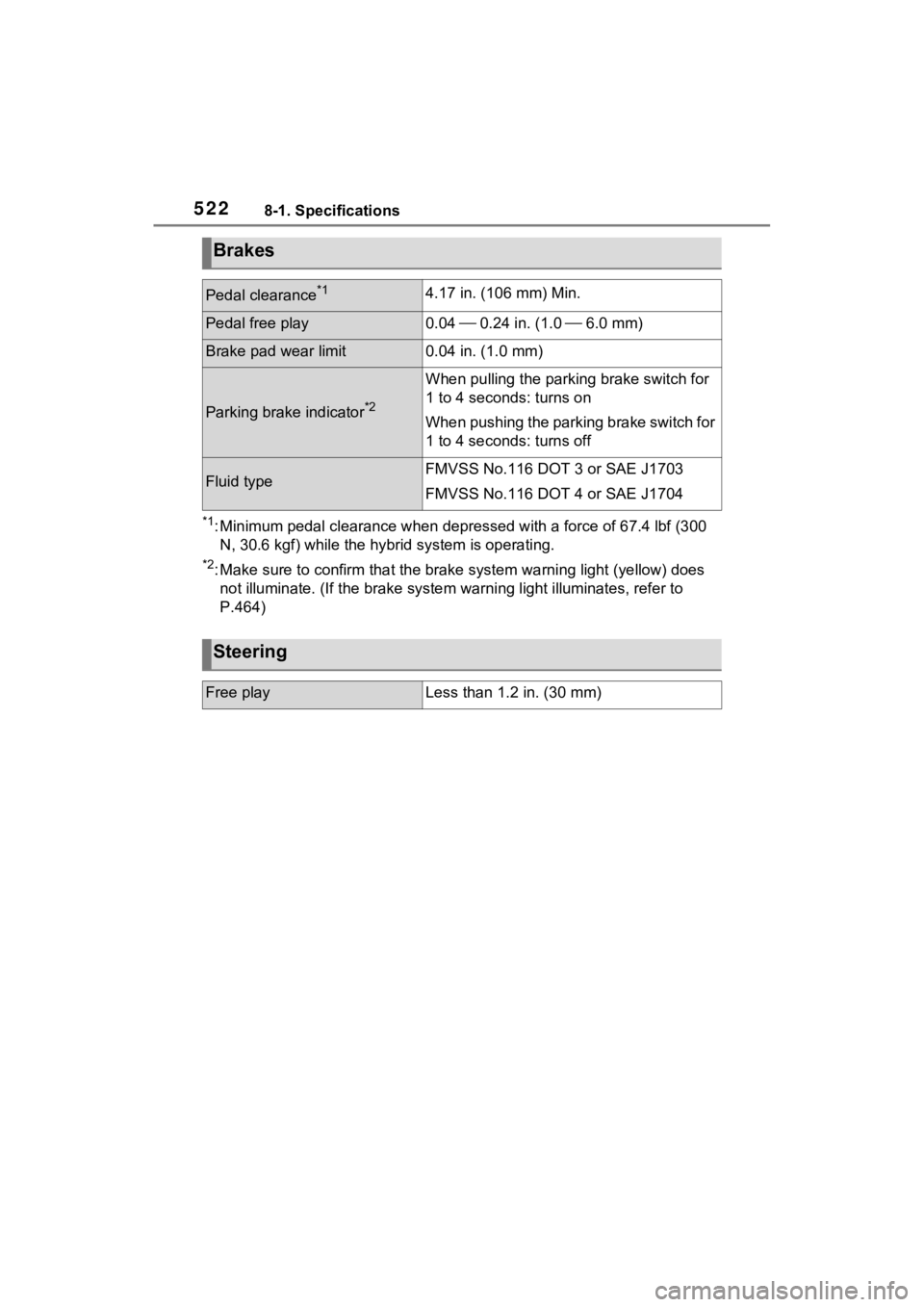
5228-1. Specifications
*1: Minimum pedal clearance when depressed with a force of 67.4 lbf (300
N, 30.6 kgf) while the hyb rid system is operating.
*2: Make sure to confirm that the brake system warning light (yell ow) does
not illuminate. (If th e brake system warning light illuminates, refer to
P.464)
Brakes
Pedal clearance*14.17 in. (106 mm) Min.
Pedal free play0.04 0.24 in. (1.0 6.0 mm)
Brake pad wear limit0.04 in. (1.0 mm)
Parking brake indicator*2
When pulling the parking brake switch for
1 to 4 seconds: turns on
When pushing the parking brake switch for
1 to 4 seconds: turns off
Fluid typeFMVSS No.116 DOT 3 or SAE J1703
FMVSS No.116 DOT 4 or SAE J1704
Steering
Free playLess than 1.2 in. (30 mm)
Page 532 of 600
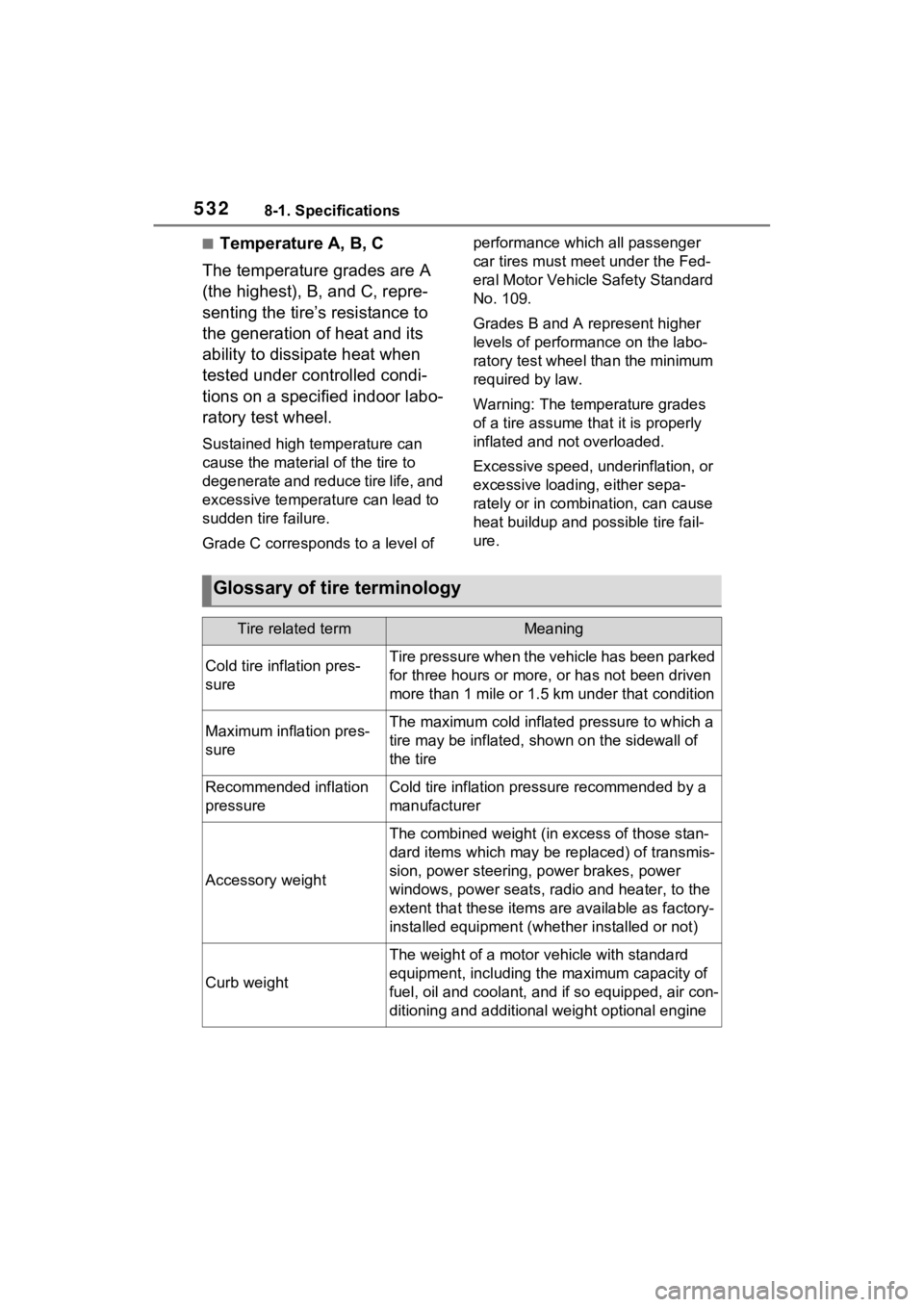
5328-1. Specifications
■Temperature A, B, C
The temperature grades are A
(the highest), B, and C, repre-
senting the tire’s resistance to
the generation of heat and its
ability to dissipate heat when
tested under controlled condi-
tions on a specified indoor labo-
ratory test wheel.
Sustained high temperature can
cause the material of the tire to
degenerate and reduce tire life, and
excessive temperature can lead to
sudden tire failure.
Grade C corresponds to a level of performance which all passenger
car tires must meet under the Fed-
eral Motor Vehicle Safety Standard
No. 109.
Grades B and A represent higher
levels of performance on the labo-
ratory test wheel than the minimum
required by law.
Warning: The temperature grades
of a tire assume tha
t it is properly
inflated and not overloaded.
Excessive speed, underinflation, or
excessive loading, either sepa-
rately or in combination, can cause
heat buildup and possible tire fail-
ure.
Glossary of tire terminology
Tire related termMeaning
Cold tire inflation pres-
sureTire pressure when the vehicle has been parked
for three hours or more, or has not been driven
more than 1 mile or 1.5 km under that condition
Maximum inflation pres-
sureThe maximum cold inflated pressure to which a
tire may be inflated, shown on the sidewall of
the tire
Recommended inflation
pressureCold tire inflation pressure recommended by a
manufacturer
Accessory weight
The combined weight (in excess of those stan-
dard items which may be replaced) of transmis-
sion, power steering, power brakes, power
windows, power seats, radio and heater, to the
extent that these items are available as factory-
installed equipment (whether installed or not)
Curb weight
The weight of a motor vehicle with standard
equipment, including th e maximum capacity of
fuel, oil and coolant, and if so equipped, air con-
ditioning and additional weight optional engine
Page 545 of 600
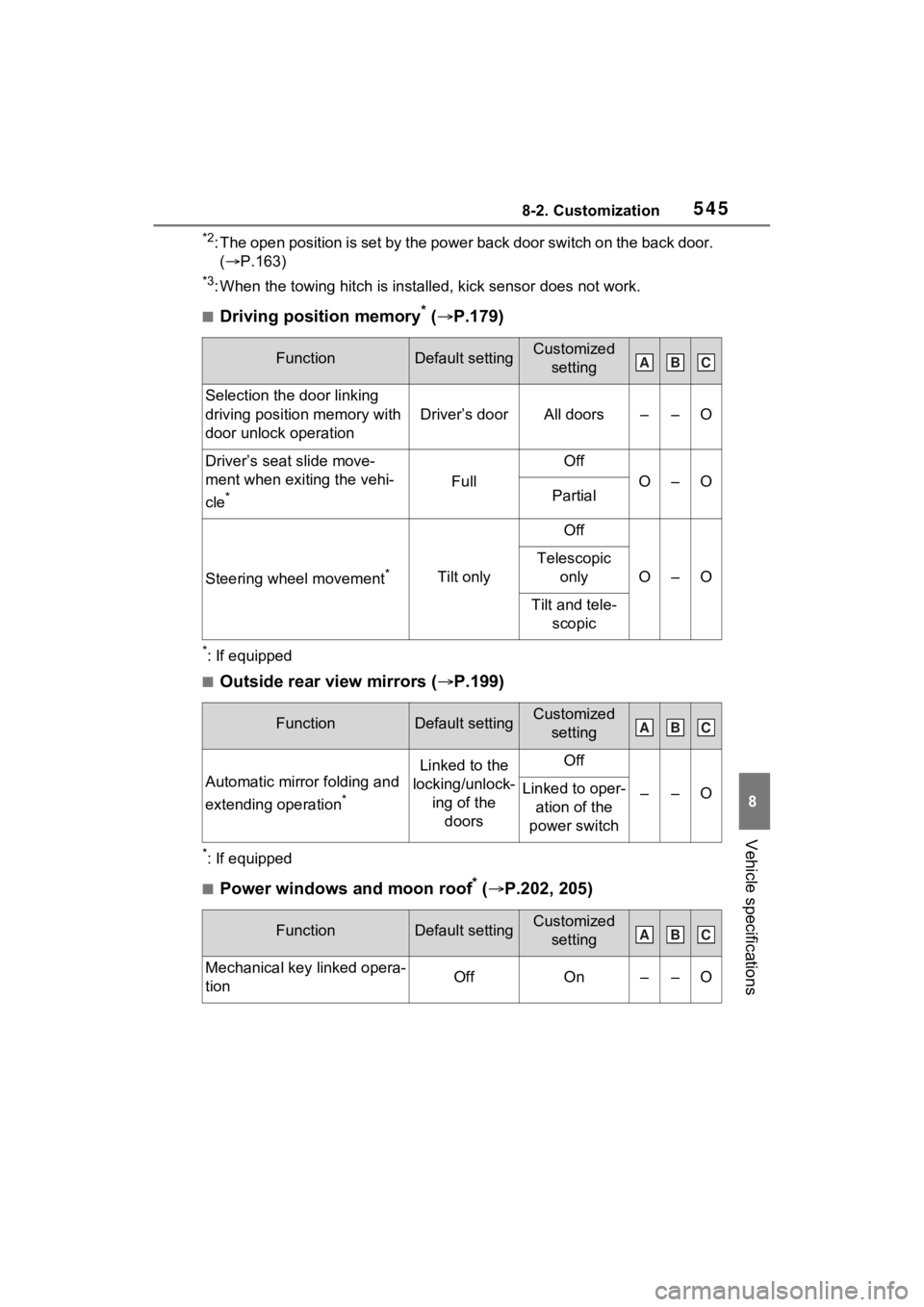
5458-2. Customization
8
Vehicle specifications
*2: The open position is set by the power back door switch on the back door.
( P.163)
*3: When the towing hitch is installed, kick sensor does not work.
■Driving position memory* ( P.179)
*: If equipped
■Outside rear view mirrors ( P.199)
*: If equipped
■Power windows and moon roof* ( P.202, 205)
FunctionDefault settingCustomized
setting
Selection the door linking
driving position memory with
door unlock operation
Driver’s doorAll doors––O
Driver’s seat slide move-
ment when exiting the vehi-
cle
*Full
Off
O–OPartial
Steering wheel movement*Tilt only
Off
O–O
Telescopic only
Tilt and tele-scopic
FunctionDefault settingCustomized setting
Automatic mirror folding and
extending operation
*
Linked to the
locking/unlock- ing of the doorsOff
––OLinked to oper- ation of the
power switch
FunctionDefault settingCustomized setting
Mechanical key linked opera-
tionOffOn––O
ABC
ABC
ABC
Page 547 of 600
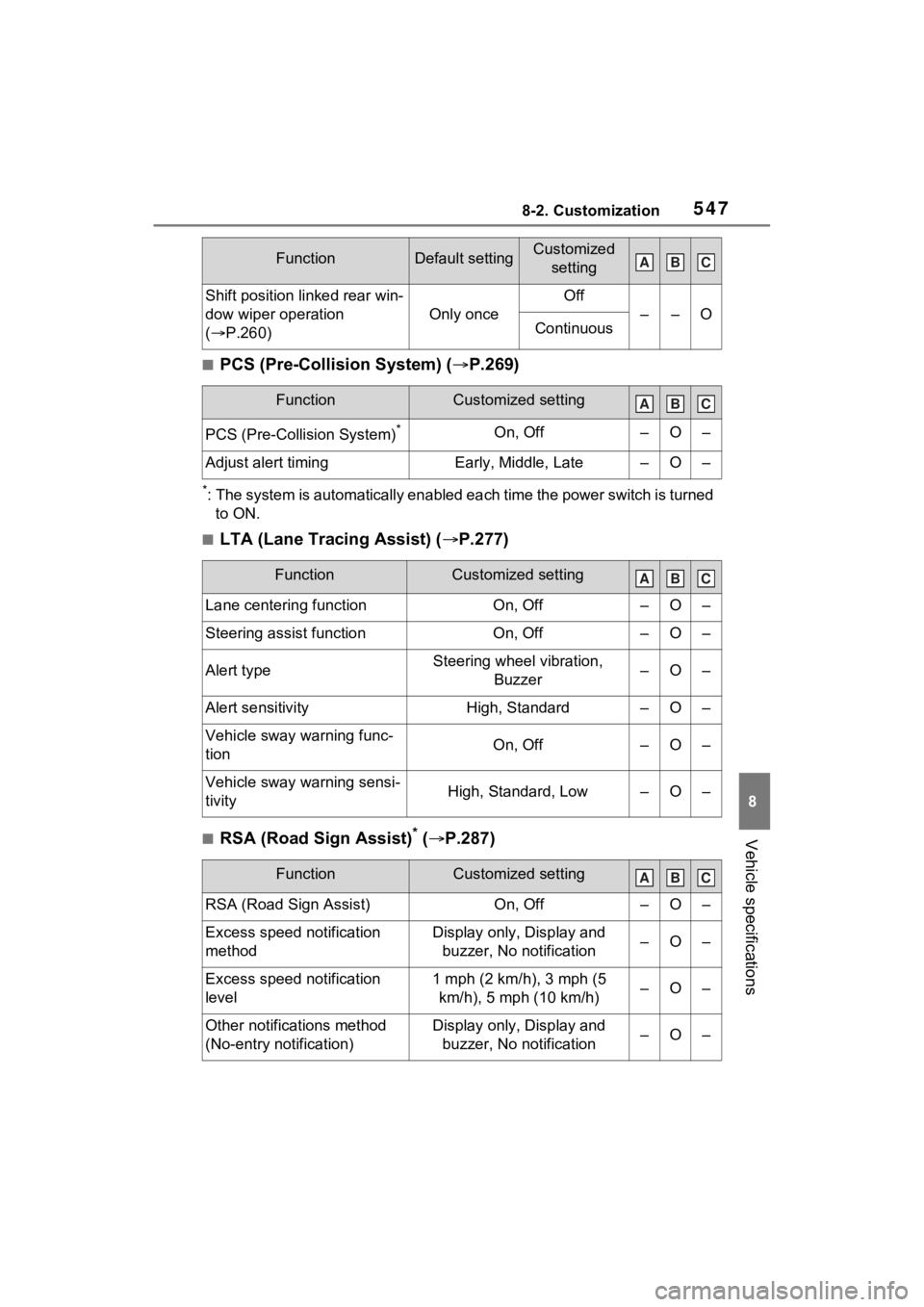
5478-2. Customization
8
Vehicle specifications
■PCS (Pre-Collision System) (P.269)
*: The system is automatically enabled each time the power switch is turned
to ON.
■LTA (Lane Tracing Assist) ( P.277)
■RSA (Road Sign Assist)* ( P.287)
Shift position linked rear win-
dow wiper operation
( P.260)
Only once
Off
––OContinuous
FunctionCustomized setting
PCS (Pre-Collision System)*On, Off–O–
Adjust alert timingEarly, Middle, Late–O–
FunctionCustomized setting
Lane centering functionOn, Off–O–
Steering assist functionOn, Off–O–
Alert typeSteering wheel vibration,
Buzzer–O–
Alert sensitivityHigh, Standard–O–
Vehicle sway warning func-
tionOn, Off–O–
Vehicle sway warning sensi-
tivityHigh, Standard, Low–O–
FunctionCustomized setting
RSA (Road Sign Assist)On, Off–O–
Excess speed notification
methodDisplay only, Display and buzzer, No notification–O–
Excess speed notification
level1 mph (2 km/h), 3 mph (5 km/h), 5 mph (10 km/h)–O–
Other notifications method
(No-entry notification)Display only, Display and buzzer, No notification–O–
FunctionDefault settingCustomized settingABC
ABC
ABC
ABC
Page 570 of 600

570Alphabetical Index
Hands Free Power Back door........................................... 155
Power back door .................. 153
Wireless remote control ....... 153
Back-up lights Replacing light bulbs ............ 448
Wattage ................................ 524
Battery (12-volt battery) ......... 419 If the 12-volt battery is dis-charged .............................. 504
Preparing and c hecking before
winter.................................. 343
Replacing ............................. 507
Warning light ........................ 464
Battery (traction battery) ......... 83
Blind Spot Monitor (BSM) ...... 301 Blind Spot Monitor function .. 304
Rear Cross Traffic Alert function........................................... 307
Bottle holders ......................... 369
Brake Brake Hold ........................... 248
Fluid ............................. 417, 522
Parking brake ....................... 245
Regenerative braking ............. 80
Warning light ........................ 464
Brake assist ............................ 334
Brake Hold .............................. 248
Break-in tips ........ ................... 211
Brightness control Instrument panel light control99, 103
BSM (Blind Spot Monitor) ...... 301 Blind Spot Monitor function .. 304
Rear Cross Traffic Alert function........................................... 307
C
Care Aluminum wheels ................. 396
Exterior ................................. 396
Interior .................................. 399 Seat belts .............................399
Cargo capacity ................217, 220
Cargo hooks............................372
Cargo net hooks .....................372
Chains......................................345
Child-protectors......................142
Child restraint system ..............58 Fixed with a LATCH system ...68
Fixed with a seat belt..............63
Front passenger occupant clas-sification system ...................51
Points to remember ................58
Riding with children ................57
Types of child restraint system installation method ...............60
Using an anchor bracket ........71
Child safety ...............................57 12-volt battery precautions .419, 508
Airbag precautions .................46
Back door precautions..........150
Child restraint system .............60
Heated steering wheel and seat heater precautio ns..............361
How your child should wear the seat belt ................................36
Moon roof precautions..........206
Power window lock switch ....204
Power window precautions...203
Removed key battery precau- tions ....................................445
Seat belt extender precautions .............................................36
Seat belt precautions..............35
Seat heater precautions .......361
Cleaning ..........................396, 399 Aluminum wheels .................396
Exterior .................................396
Hybrid battery (tr action battery)
air intake vents and filters...440
Interior ..................................399
Radar sensor ........................265
Page 572 of 600

572Alphabetical Index
Power easy access system .. 179
Driving support system informa- tion display ........................... 110
Dynamic radar cruise control with full-speed rangeFunction ............................... 290
Warning message ................ 475
E
ECB (Electronically Controlled Brake System) ...................... 334
Eco drive mode ...................... 333
EDR (Event data recorder)......... 8
E-Four (Electronic On-Demand AWD system) ........................ 335
Elapsed time ........................... 111
Electric motor Location.................................. 79
Specification ......................... 518
Electric Power Steering (EPS) Function ............................... 335
Warning light ........................ 466
Electronically Controlled Brake System (ECB) ....................... 334
Electronic key Battery-saving function......... 166
If the electronic key does not operate properly ................. 502
Replacing the battery ........... 444
Emergency, in case of If a warning buzzer sounds .. 464
If a warning light turns on ..... 464
If a warning message is dis-played................................. 475
If the 12-volt battery is dis- charged .............................. 504
If the electronic key does not operate properly ................. 502
If the fuel filler door cannot be opened ............................... 501
If the hybrid sy stem will not start
........................................... 499 If the vehicle is submerged or
water on the road is rising ..458
If you have a flat tire .....480, 490
If you lose your keys.............500
If you think something is wrong ...........................................463
If your vehicle becomes stuck ...........................................513
If your vehicle has to be stopped in an emergency .................457
If your vehicle needs to be towed ...........................................460
If your vehicle ove rheats ......509
Emergency flashers ...............456
Energy monitor .......................122
Engine Compartment........................413
Hood .....................................410
Identification number ............518
Engine coolant Capacity ...............................520
Checking ..............................416
Preparing and checking before winter ..................................343
Warning light ........................465
Engine coolant temperature gauge ...............................97, 101
Engine oil Capacity ...............................519
Checking ..............................413
Preparing and checking before winter ..................................343
Warning light ........................465
Engine oil maintenance data .415
Enhanced Vehicle Stability Con- trol (Enhanced VSC ) .............335
Enhanced VSC (Enhanced Vehi- cle Stability Control).............335
EPS (Electric Po wer Steering)
Function................................335
Warning light ........................466
EV drive mode.........................238